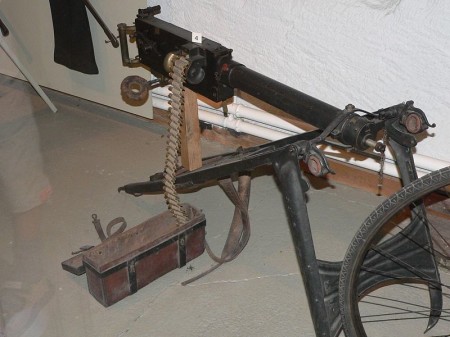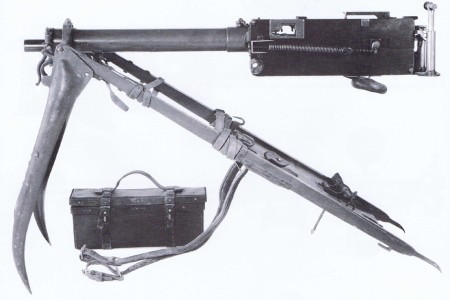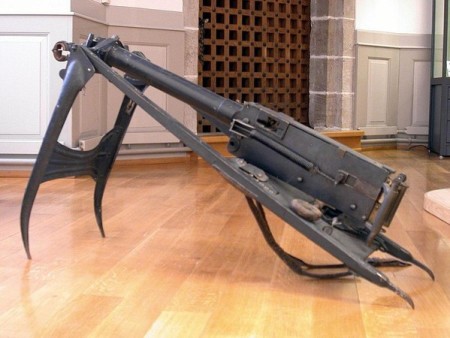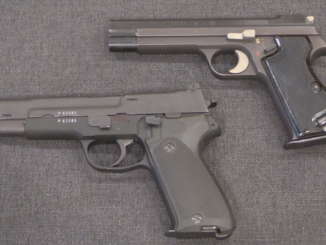When Hiram Maxim began building his machine gun, the standard cartridges of the day were still large (.45 caliber or thereabouts) black powder rounds. Maxim’s early “World Standard” guns were designed around these rounds, and it was one of them that he took to an 1887 Swiss Army trial in Thun to compete against a 2-barrel Gardner gun. Well, the Swiss were on the cutting edge of technology, and had a smallbore, high velocity 7.5mm cartridge in development. When Maxim’s gun thoroughly defeated the Gardner in competition, the Swiss requested a Maxim gun in 7.5x53mm (later changed to 7.5×55 GP90, predecessor to the long-lived GP11 cartridge).
A first attempt to simply retrofit an 11mm Maxim for the smaller round resulted in many problems, as the small round produced significantly less recoil energy with which to operate the gun’s action. Maxim revisited the design, and in 1889 delivered Maxim #165 to the Swiss government for testing. It promptly digested 4,871 rounds of ammo without and significant malfunction, and the decision was made to adopt it as the new Swiss standard machine gun. The one major objection to the design was the weight, which made the guns difficult to maneuver around Switzerland’s mountainous terrain. So, the final design changes prior to mass purchase was to reduce the diameter of the water jacket, thus reducing both its weight and the weight of the water carried in it. The result was the MG94, one of the first adopted military models of the Maxim.

Most Maxim guns are quite similar, but the Swiss MG94 has several unique features. First off, as you can see from the photo above, is the mount. It is a 4-legged quadropod mount, which is connected to the gun only by a gimbal-type connection at the muzzle. The rear end of the gun is supplied with a pair of padded rings so that the gunner can support the weight of the gun on his knees. This mount was designed for the steep slopes and rough terrain of the Swiss mountains, and allows significant flexibility on aiming the gun. However, it does not allow the precise long-range fire of the T&E screws used on other mounts.
The small water jacket also makes the MG94 pretty distinctive among Maxim guns. It did reduce the weight of the gun, but this was a tradeoff for reduced cooling capacity. The MG94 was originally made with several very early Maxim features, like the 1889-style crank handle and free-turning roller in the feed block to help bring in the ammunition belt. The crank handle design was upgraded to the “S” style later in Swiss service. Also, the MG94 was delivered without a fusee spring cover, in another move to reduce weight.

To allow easy (well, simple) transportation of the gun, the front legs of the mount could fold up, and the gun and mount carried by a single soldier using backpack-style shoulder straps. Not our idea of a fun way to hike the Alps!

All in all, just 72 of these guns were purchased by the Swiss, and they remained in inventory until after WWII. They were eventually retrofitted with antiaircraft sights, and kept in reserve in mountain outposts. Interestingly, six of them were converted early on to aircraft guns, with slotted jackets for air cooling. They were mounted on DH-1 planes, and were the first Swiss aerial armament.

Technical Specs
Caliber: 7.5mm Swiss (originally GP90; later updated to GP11)
Rate of fire: 460 rounds/min
Weight (unloaded): 21.2kg (46.7 lb)
Overall length: 1120mm (44 in)
Barrel length: 725mm (28.5 in)
Rifling: 4 groove, right-hand twist
Sights: Ladder type, 400m-2000m
Belt capacity: 250 rounds



I think the Swiss reasoned that the smaller barrel jacket was acceptable because it is pretty cold in the mountains and Switzerland in general.
Running up and down those mountains you will get warm despite all of that cool air! But as soon as you stop you will be cold! Bill in Boulder
“It’s all uphill from here!”
I think Big Al may be right about the logic behind the weight trade-off with the smaller water cooling jacket vis-a-vis ambient temperature in the Alps. Did the unloaded weight of 21.2 kg ( 46.7 lbs ) stated above include the quadrapod mount?
I’m not 100% sure, but I believe that is without the mount.
I can confirm Big Al’s comment. Our grandfather did save weight caused by cold temprature here in Switzerland and the mostly available snow to cool the gun at anytime.
I’m a mountaneer (Gebrigsgrenadier) and we today still use the advantage of the cold weather and the available snow.